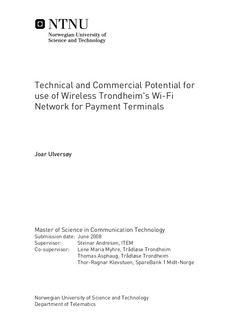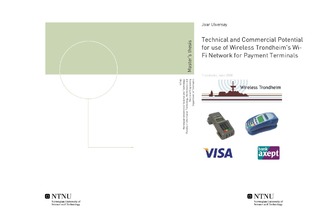| dc.description.abstract | Wireless Trondheim is a company offering city-wide Wi-Fi network in Trondheim, seeking new ways to utilize the Wi-Fi network to increase the number of services offered, and also increasing the profits and total revenues. Payment cards are very popular in Norway, and merchants such as cafés or restaurants, or merchants at temporary events, may want to use wireless payment terminal in order to provide a convenient and easy way for customers to pay for their purchases. This thesis will address the technical and commercial potential of using payment terminal within Wireless Trondheim's Wi-Fi network. A study of the technical potential of using payment terminals within Wireless Trondheim's Wi-Fi network reveals two companies importing and configuring payment terminals in Norway, and that currently two terminals exist with Wi-Fi support. However, the security related to using terminals with Wi-Fi is not yet approved by the Banks' Standardization Office, which means that it is not possible to use payment terminals with Wi-Fi until the security has been approved. The test of a payment terminal in Wireless Trondheim's Wi-Fi network was not possible to conduct for the same security reasons. Among the two existing payment terminals with Wi-Fi, only one is available in Norway. This terminal is produced by Banksys and is called Xentissimo, and supports both GPRS, GSM and Wi-Fi. Ingenico 7810 is the other existing payment terminal with Wi-Fi, but this terminal does not have any other wireless communication option. A cost comparison of the different wireless payment access alternatives from the perspective of a merchant shows that Netcom GPRS is currently the cheapest alternative. Telenor GPRS is the second cheapest alternatives for low estimates of number of terminals and transactions for a typical café in Trondheim, while Ventelo broadband Point of Sale is the second cheapest alternative for a similar high estimate. Based on this comparison, a competitive and attractive price for the service offered by Wireless Trondheim has been determined and used to calculate revenues in the business model proposal. The business model proposal provided in this study is based on the high level elements of Osterwalder's Business Model Ontology. The model explains how Wireless Trondheim, in cooperation with the local branches of banks, can offer wireless access to payment terminals using Wireless Trondheim's Wi-Fi network. The chosen target customers for this service are cafés, restaurants and merchants at temporary events in the city of Trondheim, and the cooperation with the banks has been chosen in order to utilize the bank's existing distribution channels towards these target customers. The business and technical risks that this business model face are identified and described. Net present value calculations of the business model show negative results in the pessimistic and realistic scenario of market share, while the optimistic scenario gives a small positive net present value. These results suggest that the Wi-Fi connection offered by Wireless Trondheim is not cost-effective compared to Netcom GPRS, and that the business model proposed in this thesis does not have a commercial potential with the current customer estimates. However, if the Wi-Fi coverage increases and the number of potential customer increases substantially, it could be interesting to pursue this business model proposal further. An interesting possibility could also be a combination of offering payment access to terminals and Internet connection to merchants. The number of potential customers would then in that case be considerably larger, as the target customers would include most merchants in Trondheim, and not only be limited to restaurants, cafés and merchants at temporary events. | nb_NO |

